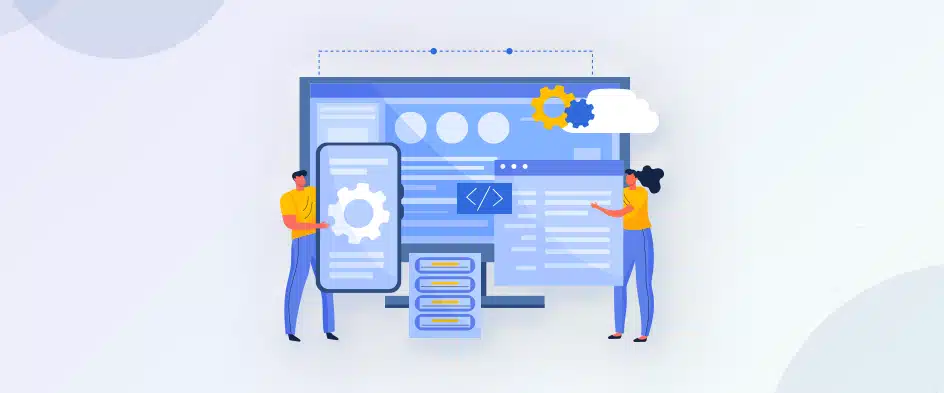How to Choose the Right Backend Technologies for Web Development

- 6 Minutes to read
Table of Content
- What are Backend Technologies for Web Development?
- Benefits of Using Backend Technologies
- Popular Backend Technologies for Web Development
- Factors for Choosing a Backend Technology
- Best Practices for Backend Development
- Real-World Examples of Backend Technologies in Web Development
- Summary
- FAQs on Backend Technologies for Web Development
The top web development companies treat a website like a house. They divide it into two parts: frontend and backend. The frontend developers are responsible for the visible parts of the house (like design, paint, landscaping, etc.). And the backend developer would be responsible for the fundamental parts of the house (like the foundation, HVAC, wiring, plumbing, etc.).
Let’s focus on the latter for now. When we explore backend tech, we find a plethora of tools and frameworks. There are plenty of options, from Python, Java, and Ruby to Django and Laravel. Each tech has its own advantages, so devs can pick what best fits their project.
Backend tech is great at handling huge amounts of data. It integrates with databases, making it possible to store and access info for websites or apps. Companies can build powerful systems that can handle lots of traffic without any loss in performance.
So, let’s start with what backend technologies for web development are.
What are Backend Technologies for Web Development?
Backend techs for web development are tools, frameworks, and programming languages used to develop the server side of a website or app. They manage user requests, databases, and communication between the server and front end.
As websites and apps get more complex, developers need robust techs to handle tasks efficiently.
- Node.js lets developers use JavaScript on the server side. It syncs frontend and backend dev.
- Ruby on Rails is simple and time-saving. It follows the “convention over configuration” principle, making it easier to build apps quickly.
- Python’s Django framework offers high flexibility and scalability, so it’s popular for complex web apps.
Backend technologies also protect user data from malicious attacks with encryption and authentication mechanisms. An e-commerce website had a major security breach due to a vulnerability in their backend system. This emphasizes the importance of choosing secure tech and implementing best practices to safeguard info.
Benefits of Using Backend Technologies
Backend technologies are essential for web development, bringing heaps of benefits to the functionality and performance of a website.
- Security: Backend tech guards sensitive info from unauthorized access. This lowers the risk of cyber threats.
- Data Management: Database and storage systems help manage and manipulate large volumes of data with ease.
- Scalability and Flexibility: Websites can be adapted and customized according to business needs, as backend tech offers flexible frameworks and tools.
Plus, backend tech gives detailed analytics and insights into website performance and user behavior without compromising speed or efficiency.
Popular Backend Technologies for Web Development
Backend technologies are essential for web development. They provide the base for website performance and functionality. They allow server-side processing and communication between the user interface and databases. Here is an overview of popular backend technologies for web development:
| Technology | Technology | Language(s) | Framework(s) |
|---|---|---|---|
| Node.js | JavaScript runtime environment | JavaScript | Express.js |
| Django | High-level Python web framework | Python | Django REST |
| Ruby on Rails | Server-side web application framework | Ruby | Rails |
| ASP.NET | Framework for building dynamic websites | C#, Visual Basic | ASP.NET MVC |
These technologies offer different features and languages to fulfill various development needs. For example:
- Node.js provides scalability and efficiency with its event-driven architecture. And you can even opt for the top Node.js development companies for building real-time applications, such as chat apps and multiplayer games.
- Django has a ‘batteries-included’ approach for rapid development.
- Ruby on Rails focuses on ‘convention over configuration’ so developers can build apps quickly.
- And ASP.NET allows integration with other Microsoft tools.
When selecting a backend tech for your project, consider scalability, security, community support, and performance requirements. Make sure you are familiar with the language and framework for efficient development.
Here’s a Pro Tip. Keep up-to-date with your chosen backend technology. It helps maintain security and benefit from improved features and performance enhancements.
Factors for Choosing a Backend Technology
Are you trying to choose the best backend technologies for your website? Then, there are some key factors to take into account. These include scalability, performance, security, flexibility, and community support. Here’s what you need to consider:
1. Scalability
Scalability is the ability of a website or system to handle increased traffic and data without sacrificing performance. When choosing a backend technology, you need to consider the expected traffic and data load for your website or web application. You also need to consider whether the technology supports horizontal scaling and load balancing.
2. Performance
Performance is another crucial factor to consider when choosing a backend technology. You need to choose a technology that can handle your expected traffic load and provide fast response times. You should also consider whether the technology has caching features to improve performance.
3. Security
Security is essential for any website or web application. When choosing a backend technology, you need to choose one that has robust security features, such as encryption, authentication, input validation, and protection from SQL injections and XSS attacks.
4. Flexibility
Flexibility is also a significant factor to consider. You need to choose a backend technology that is compatible with different languages and has frameworks/libraries available to make development easier. You should also consider whether the technology is easy with customization and integration with other systems.
5. Community Support
Community support is important for any technology. When choosing a backend technology, you need to choose one that has a strong community of developers and users who can provide support and answer your questions. You should also consider whether the technology has well-written documentation and whether it is regularly updated.
In addition to the above factors, you may also want to consider the following when choosing a backend technology:
- Cost: Some backend technologies are more expensive than others to implement and maintain.
- Learning curve: Some backend technologies are more difficult to learn than others.
- Maturity: Some backend technologies are more mature and have been around longer than others.
It is important to weigh all of these factors carefully when choosing a backend technology for your website or web application. There is no one-size-fits-all answer, as the best backend technology for you will depend on your specific needs and requirements.
Tip: Prioritize tech based on your project needs, not trends. Research and seek advice to make an informed choice that will set your web dev up for success.
Best Practices for Backend Development
Let’s say you have chosen the best backend technology for web development. After that, you need to follow some crucial guidelines to ensure smooth functioning and the most optimal performance.
- Simplify the code structure. Make it clear and concise. Plus, organize it into logical modules and functions. This way, you can easily troubleshoot and make updates without impacting the system.
- Secure sensitive data. Implement authentication processes, encrypt data, and update security patches. This safeguards against potential vulnerabilities and unauthorized access.
- Optimize database performance. Techniques such as indexing, caching, and normalization make query execution faster.
- Proper error handling. Anticipate errors and handle them gracefully. Log errors, display user-friendly messages, and implement exception handling.
These best practices provide the foundation for developing quality apps with scalability and maintainability. Also, stay updated with emerging technologies like serverless architecture and microservices for cutting-edge solutions.
But let’s say you want to implement these best practices for backend development and don’t have the necessary skills or resources for the same. Then, you may contact the best web development companies. These companies have the professionals and resources to use the best backend technologies and create the best server-side architecture.
Real-World Examples of Backend Technologies in Web Development
Let’s check out the best backend technologies for creating the server-side architecture of a website.
| Backend Frameworks | Ruby on Rails, Django, Laravel |
| Database Management Systems | MySQL, PostgreSQL, MongoDB |
| Server-side Languages | Java, Python, PHP |
Moreover, other technologies are important for web development. For instance, cloud services like AWS or GCP. Plus, API integrations with third-party apps for features like payment gateways and social media logins.
Backend technologies play a huge role in web development by enabling complex functionalities. This makes websites dynamic and interactive. Developers can use these technologies to create powerful systems that meet various business needs. Plus, they ensure optimal performance and scalability.
Summary
Choosing the right backend technologies for web development is essential because it’s responsible for handling critical, server-side functions of a website. So consider the factors like performance, scalability, and security, and choose the backend tech like,
- Node.js and Django for handling heavy traffic
- Ruby on Rails and Laravel for security
- ASP.NET Core and Java Spring Framework for performance, and many more.
If you need more information on the backend technologies for web development or want to know about the best companies in this space, have a chat with our experts today!
FAQs on Backend Technologies for Web Development
1. What are backend technologies for web development?
Backend technologies for web development are the tools, frameworks, and programming languages used to build and maintain the server-side of a website or web application. They handle tasks such as retrieving and storing data in databases, processing user requests, and managing server resources.
2. What are some popular backend technologies?
Some popular backend technologies for web development include:
- Node.js
- PHP
- Ruby on Rails
- Python (Django, Flask)
- Java (Spring Boot)
- .NET (ASP.NET)
3. What is the role of a backend developer?
A backend developer is responsible for developing the server-side logic and APIs required for a website or web application to function. They handle tasks such as database integration, server configuration, and data processing. Backend developers work closely with frontend developers to ensure smooth communication between the server and the client side of the application.
4. How do backend technologies interact with databases?
Backend technologies interact with databases by utilizing database management systems (DBMS) such as MySQL, PostgreSQL, MongoDB, or Oracle. They use programming interfaces and query languages to retrieve, store, and manipulate data in the database.
Backend developers write queries and interact with the DBMS to manage the data flow from the server to the database and vice versa.



